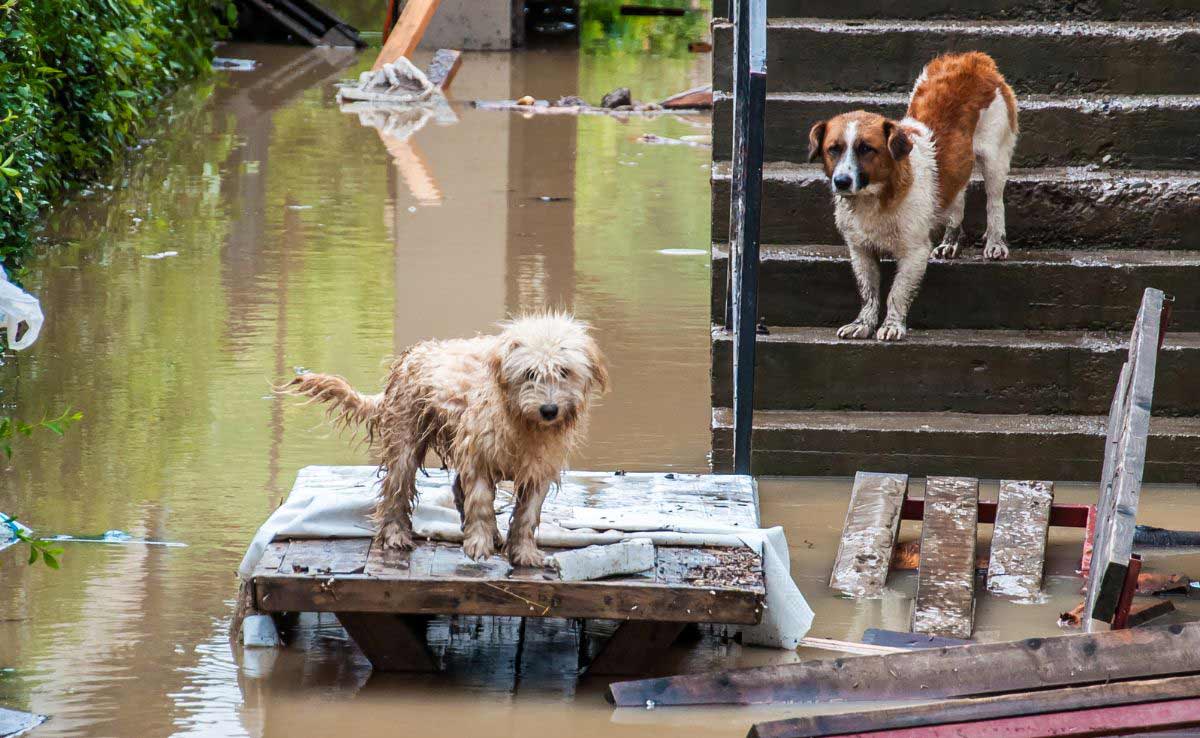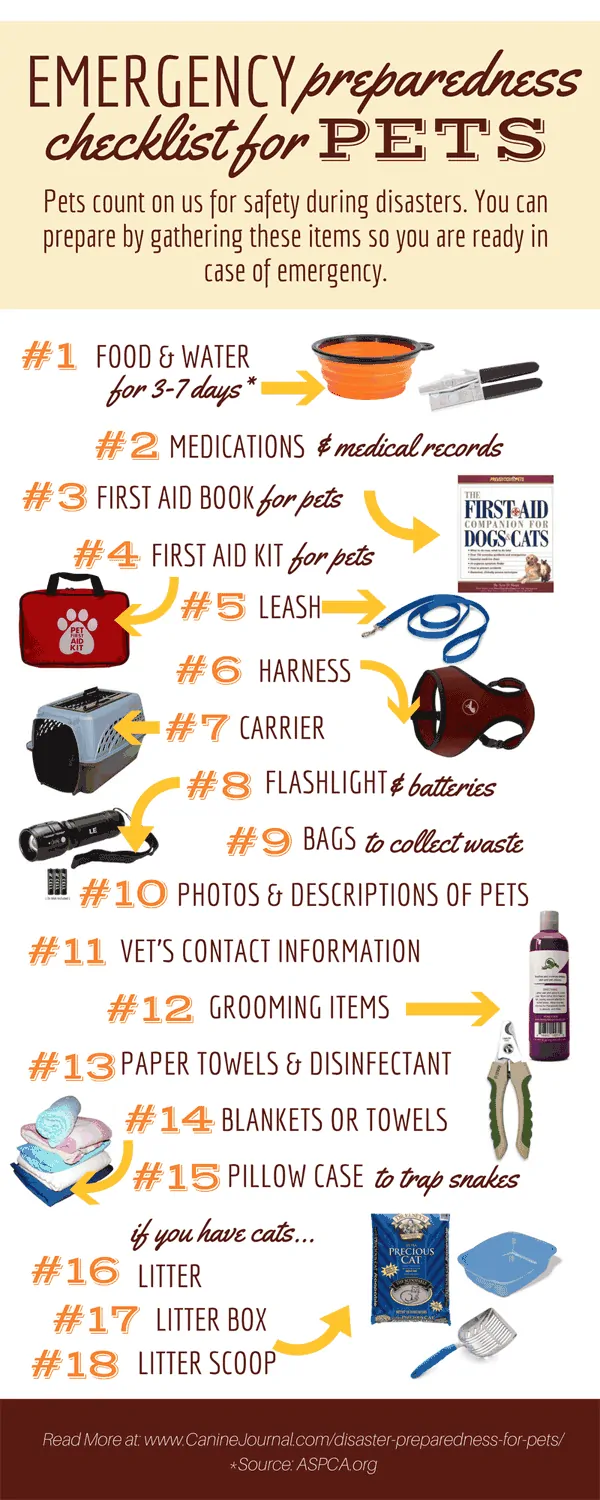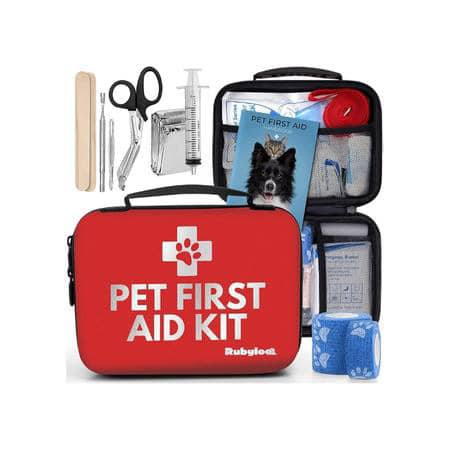Your Essential Guide To Disaster Preparedness For Pets
When you purchase through links on our site, we may earn a commission. Here’s how it works.

When a natural disaster or pandemic strikes, you have lots to care for and consider. In addition to making sure you meet your own needs, it’s essential not to forget about your pets too. Remember, if a storm, hurricane, tornado, pandemic, or other possible threat is dangerous for you, there are also hazards for your pet.
Table of Contents
So if you are evacuating your home, be sure to bring your furry, scaly, or other textured pet along with you. And if you hunker down, make sure you’re stocked up on supplies. Learn how pet disaster preparedness can save your best friend’s life.
Emergency Preparedness For Pets
In a PetFirst survey of 50,000 pet parents, 50% said they worry about their pet in a natural disaster, yet less than a third have a pet first aid kit1. While having an extra supply of food is a good idea, you’ll need more than you think, especially if you don’t have power or access to a vet.
Below are some tips and guidelines to consider for emergency preparedness for dogs, cats, and other small domestic animals. This is not a comprehensive list, and needs vary based on the animal.
What To Include In A Pet First Aid Kit?
At a minimum, you’ll want to have these items ready to go at a moment’s notice. Food and medication (1 & 2 below) are the most important items you must prioritize.
- The ASPCA suggests food for 3-7 days, including bowls and a travel can opener if needed.
- Medications and medical records in a waterproof container or bag.
- The Humane Society recommends 1 gallon of water per person and animal (depending on size) for at least 5 days, plus an extra gallon for cleaning. You might consider a dog water bottle that has a built-in dispenser for drinking on the go.
- Pet first aid kit and a pet first aid book to educate yourself on how to do basics such as cleaning a wound, making a splint, and how to perform CPR on dogs.
- Sturdy leashes and carriers to transport animals.
- Harness with reflective material to see in the dark.
- ID Tag with your up to date cell phone number or a GPS collar to track them if you get separated. You’ll also want to have photos and detailed descriptions of each pet in case one gets lost.
- Feeding instructions and vet’s contact information in case you need to board or place them in foster care. Download ASPCA iOS App to store all this info electronically, along with additional advice on the go.
- Bags to collect pet waste (or plastic grocery bags work fine) and litter, litter box, and litter scoop if you have a cat
You also want to make sure your pets are vaccinated because they may be exposed to diseases through contaminated water.
Other Useful Items To Include
Space and circumstance willing, these are also good to have available:
- Grooming items (e.g., brush, clippers, shampoo) plus paper towels and disinfectant wipes as there can be dirty and damp conditions, especially during hurricanes and flooding
- Blankets or towels for warmth and dryness.
- A dog life jacket in case you have to evacuate via water and your pup needs assistance swimming or staying afloat.
- Flashlight and batteries to help you navigate during a power outage.
- For snakes, gerbils, or other small reptiles, pillowcases for transportation.
Don’t forget about horses, chickens, and rabbits and their unique needs too!
Financial Planning For Health Emergencies
While it is true your dog will need to come with you in a natural disaster, it is even more likely that your pup will suffer from an accident or unexpected illness of its own in its lifetime. The vet treatment for this unexpected vet visit could add up to thousands of dollars, depending on the diagnosis. This is why it is essential to plan for these times by getting a pet insurance policy from a respected provider. You will want to read several reviews of pet insurance companies before you sign up so you are confident that your policy covers the needs you are most concerned about for your pet.
Tips For Riding Out The Storm With Your Pet
During a storm, you will want to stay with your pets as much as you can. They will rely on you to feed them and give them water. Dwight Alleyne, DVM and Veterinarian Expert at JustAnswer, says, “If possible, you should try to keep them in an interior room, preferably away from windows.” He also recommends keeping them distracted with treats and their favorite toys while the storm is going on. And if you are riding out the storm with your pets, be sure to place signs or stickers on your front door indicating that there are pets in the household, which can help with rescuers.
Emergency Preparedness Checklist For Pets
You might not always have the clearest head when you’re in panic mode, so having a list to reference ensures you won’t let anything slip through the crack! To help you remember what to pack, we put together this handy checklist so you can quickly and easily remember what to grab in case an emergency arrives.
Print this out today and put it on your fridge, so you know what to pack up if an urgent matter presents itself.

Pandemic Planning Is Crucial As Well
The 21st century has brought many challenges, but COVID-19 was its first worldwide pandemic. Dogs and cats have a limited risk of contracting COVID-19. But, when faced with times of panic and potential quarantine, parents need to prepare for their pets too.
How To Prepare Pets For A Pandemic Quarantine
- Nutrition: Ensure you have at least 2 weeks of dog or cat food on hand per pet. This includes treats too. Better yet, have it all delivered to your home with online dog food delivery services or subscriptions!
- Medication: Get a minimum of 2 months’ worth of any medication that your pet takes regularly. As we head into flea and tick season, you should also stock preventative treatments.
- Breaks: Just because you don’t plan to leave the house doesn’t mean your dog is trapped inside. Ensure your pup is getting plenty of exercise. If anything, letting them out to pee is an excuse to get off the couch (and take a break from binge-watching Netflix).
- Bathing: Your pup needs regular baths to keep them clean and comfortable.
- Travel: If your travel plans change, be sure to give ample notice to your dog’s daycare and/or sitter so they can plan accordingly. Also, ask if there are fees related to last-minute travel changes.
- Activities: Being trapped inside will give you and your fur baby more time together to bond. Try teaching them a new trick. Your pet might also become bored or anxious. To calm their nerves, keep extra toys around and talk to your vet about using CBD oil.
Pets In Need During Disasters: Facts & How You Can Help
As we’ve seen from previous natural disasters (including the devastation in Houston after Hurricane Harvey’s flooding and in the Caribbean after Hurricane Maria tore through the islands before making its way up the east coast), there tends to be an influx of shelters rescuing abandoned or missing pets.
In fact, between late August and the end of 2017, the ASPCA alone assisted nearly 37,000 animals affected by Hurricanes Maria & Irma and the wildfires in Northern California2. Richard Grsyeen, Ed.D., the senior director of disaster response for ASPCA, notes that during relief efforts, the pet population equals about 52 to 59% of the human population. This means there’s one pet for every 2 people to keep track of in an emergency.
Luckily some organizations step up to help find warm, happy homes for the thousands of displaced dogs, cats, and other pets. If you are in a surrounding area of a natural disaster, consider reaching out to your local shelter to find out ways you can help. In addition to adoption, supplies, and volunteer are always needed in rescue efforts and fostering pets temporarily.
And no matter where you live, you can donate money to assist in the efforts on the ground. There are hundreds of animal rescue organizations, and one that has shelters in many areas around the country is The ASPCA. Check on their website to find a shelter near you.
Red Rover is another organization that provides an emergency safety net for animals, offering accommodations and care for animals displaced by natural disasters. And if there’s a favorite animal welfare charity that you support, please let us know with a comment below!
June Is National Pet Preparedness Month
June is National Pet Preparedness Month, educating pet owners on ways to be prepared for an emergency when it arises. The timing is critical since summer is the start of the hurricane season, along with increased wildfires, tornadoes, and more.
We at Canine Journal are committed to spreading awareness about how to keep pets safe and out of harm’s way year-round. In September, we celebrate National Preparedness Month, and with the abundance of tropical storms during this time, it couldn’t be timelier.
Build Your Own Pet First Aid Kit (Video)
Here are some tips from the American Red Cross, and be sure to check out our article dedicated to pet first aid kits.
Pets Are Our Family
Pets count on us for safety, so it’s up to us to take care of them during disasters. The best way to keep them safe is to prepare ahead of time. That’s why disaster preparedness for pets is so important.
Be proactive now while you still have electricity, gathering the items into a bag so you’re ready for any situation. If your dog does get into harm’s way, here are some useful articles, including the best way to treat a poisoned pup and how pet insurance can help you save money if there’s an emergency.
Sources: [1] PetFirst Pet Insurance 2019 Survey, [2] Domestic Preparedness




